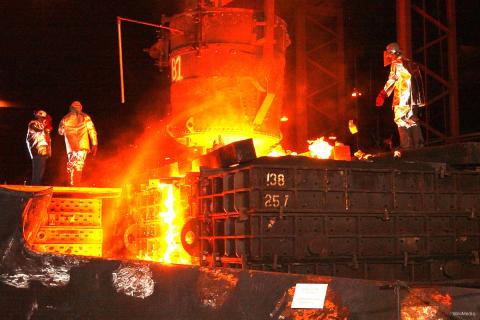Age of Iron
Iman Ibrahim Al-Kandari
The first Iron Age at some unknown but distant date in prehistory when human beings discovered low to make iron from iron ore in the ground and sue it to manufacture weapons and implements that were superior to those made of bronze. In .France, some where about the year 1400, the introduction of the blast furnace made it possible to smelt the are into cast iron in larger quantities. The bellows were usually driven by water wheels and the molten metal was poured into molds.
The second Iron Age began in Engan in England in 1709 when Abraham Darby devised a way of smelting iron with coke instead of charcoal This gave the industry a new source of fuel, but it still depended on water for power. The first successful steam engine was built by Thomas Newcomen and installed in 1712 at a coal mine in Dudley in the English Midlands to pump water out of the levels by 5 1/2 horsepower, Better steam engines were developed by James Watt, that could turn a shaft, and so drive machinery.
Mean while, the textile industry was being revindustry by the invention of spinning and weaving machinery. In 1771, Richard Arkwrighi opened his cotton mill, powered by water wheels, at cromford in Derbyshire, where the spinning manchines were worked by women and children labored in 12-hour shifts six days a week.
Soon, steam engines turned Britain into the world's work shop, and the steam was the power that drove the Industrial Revolution. It was the key metals were iron and its derivatives, steel.
As the rail roads introduced unprecedented speed of communication, the greatest of the railroad engineers, Isambard Kingdom Brunel built the SS Great Britain in a Bristol dock. He constructed an oceangoing, steam-driven iron ship to extend his London - to -Bristol rail line on to New York.
ByI809, steam powered factories in Ruhr Valley in Germany became one of the major industrial areas, Industrialization followed in the coalfield areas of France and Belgium, and along the 'eastern seaboard of the United states of America. Engineers usurped the functions of architects in the 19th century as designers of a whole category of important constructions, in 1851. the largest building the world had ever seen, the Crystal Palace erected for the Great Exhibition in London.
was constructed of prefabricated sections of iron and glass. Iron girders provided the skeletons of taller constructions such as Eiffel tower in Paris.
Domestic life was transformed too. Houses were equipped with iron kitchen stoves, pots and pans, fire grates, tables, garden seats and ornaments, vases, letter boxes, and windows frames,. The streets bristled with iron gates and lamp posts, drinking fountais, horse troughs and bollards.
Reference: Beatona Magazine - Environment Public Authority - Issue No. 15









